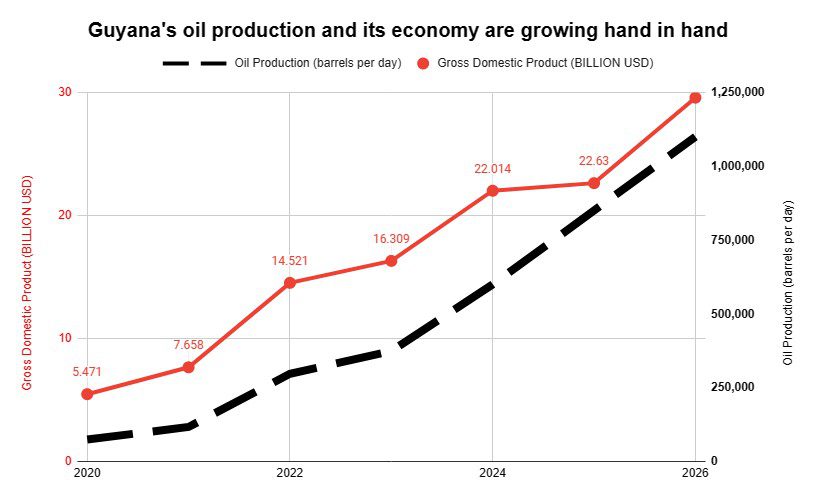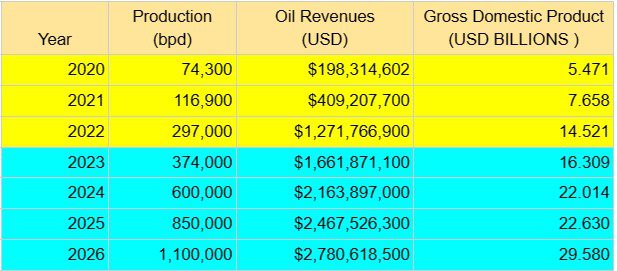The growth of oil production offshore Guyana is singlehandledly propelling Guyana’s national economy forward. That much has been obvious for the past few years. An examination of the data shows just how striking this correlation is between the two.

In 2020, Guyana produced 74,300 barrels per day (bpd) of oil, generating US$198.3 million in oil revenues and contributing to a GDP of US$5.471 billion. As oil production expanded in subsequent years, both oil revenues and GDP experienced substantial growth. The oil revenues deposited into the Fund in 2022, for example, grew seven times the 2020 amount, to US$1.42 billion.
Growth in oil production and gross domestic product from 2023 onward, in Figure 1, are projections from the Ministry of Finance and the International Monetary Fund respectively. They show that, by 2026, oil production is projected to reach 1.1 million bpd, resulting in of US$29.58 billion. In 2026, US$2.78 billion is expected to be deposited into the Fund. This substantial increase in oil production and the subsequent rise in revenues is expected to have an outsized impact on Guyana’s economy. Oil is therefore taking up a greater portion of the national economy each year.

The data clearly demonstrates a positive correlation between offshore oil production, oil revenues, and Guyana’s GDP growth. It is no surprise that in recent arguments before the court concerning insurance in the event of an oil spill offshore Guyana, the Executive Director of Guyana’s Environmental Protection Agency (EPA), Kemraj Parsram, has argued that the unprecedented growth the country is currently experiencing is in large part due to the exploitation of the country’s petroleum reserves.
The increase in oil production and the corresponding revenue-hike, are creating employment and entrepreneurial opportunities as well. Local Content legislated at the end of 2021, has already proven itself to be a powerful mechanism that can be used to help non-oil sectors grow rapidly and mitigate Dutch Disease symptoms. Guyanese businesses are raising standards and are emerging to support the oil industry, leading to business expansion and diversification.
Revenues from oil are allowing for increased government spending on infrastructure development, social programs, and public services. It will be important for Guyana to manage its newfound resources responsibly to ensure that the benefits of oil production are equitably distributed for sustainable and inclusive development.
The government has highlighted behemoth plans for the country’s infrastructural and social expansion in the next few years. This momentum would be stopped dead in its tracks if oil production were to be affected. The government has therefore moved to build a working relationship with ExxonMobil and its partners that allows the government increased input into the planning and development of projects long before the development plans are submitted for review and approval.
With five projects approved so far, another is in the application stage. The Whiptail project would be ExxonMobil’s sixth, and is expected to raise production offshore Guyana above 1.3 million barrels per day (bpd) by 2027.



